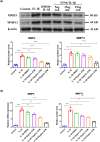Stigmasterol alleviates endplate chondrocyte degeneration through inducing mitophagy by enhancing PINK1 mRNA acetylation via the ESR1/NAT10 axis
- PMID: 40226364
- PMCID: PMC11992624
- DOI: 10.1515/biol-2022-0913
Stigmasterol alleviates endplate chondrocyte degeneration through inducing mitophagy by enhancing PINK1 mRNA acetylation via the ESR1/NAT10 axis
Abstract
Intervertebral disc degeneration (IVDD) is a core factor in spinal degeneration. To date, there is no effective treatment for IVDD. It is urgent to identify the pathogenesis of IVDD to develop effective strategies for IVDD treatment. Alleviating endplate chondrocyte degeneration is a promising strategy for IVDD treatment, while mitophagy prevents degeneration of endplate chondrocytes. Stigmasterol (STM) protects neurons from injuries by triggering mitophagy, yet the effect of STM on the mitophagy of endplate chondrocytes in IVDD has not been reported. In this study, endplate chondrocyte degeneration was induced by interleukin-1β, and the ribonucleic acid (RNA) acetylation level was identified by acetylated RNA immunoprecipitation. Herein, results indicated that STM alleviated endplate chondrocyte degeneration. Besides, STM induced PTEN-induced kinase 1 (PINK1)-mediated mitophagy in degenerated endplate chondrocytes. Moreover, N-acetyltransferase 10 (NAT10) increased PINK1 expression by improving PINK1 mRNA acetylation in endplate chondrocytes. In addition, STM regulated NAT10 expression by estrogen receptor 1 (ESR1) in degenerated endplate chondrocytes. In summary, the present study revealed that STM attenuated endplate chondrocyte degeneration through inducing mitophagy by enhancing PINK1 mRNA acetylation via the ESR1/NAT10 axis. These findings would provide novel strategies for the treatment of IVDD.
Keywords: RNA acetylation; endplate chondrocyte degeneration; intervertebral disc degeneration; mitophagy; stigmasterol.
© 2025 the author(s), published by De Gruyter.
Conflict of interest statement
Conflict of interest: Authors state no conflict of interest.
Figures






Similar articles
-
Intermittent cyclic mechanical compression promotes endplate chondrocytes degeneration by disturbing Nrf2/PINK1 signaling pathway-dependent mitophagy.Hum Cell. 2023 Nov;36(6):1978-1990. doi: 10.1007/s13577-023-00959-7. Epub 2023 Aug 3. Hum Cell. 2023. PMID: 37535221
-
Iron overload promotes intervertebral disc degeneration via inducing oxidative stress and ferroptosis in endplate chondrocytes.Free Radic Biol Med. 2022 Sep;190:234-246. doi: 10.1016/j.freeradbiomed.2022.08.018. Epub 2022 Aug 15. Free Radic Biol Med. 2022. PMID: 35981695
-
Naringin safeguards vertebral endplate chondrocytes from apoptosis and NLRP3 inflammasome activation through SIRT3-mediated mitophagy.Int Immunopharmacol. 2024 Oct 25;140:112801. doi: 10.1016/j.intimp.2024.112801. Epub 2024 Aug 8. Int Immunopharmacol. 2024. PMID: 39121608
-
Region-specific mitophagy in nucleus pulposus, annulus fibrosus, and cartilage endplate of intervertebral disc degeneration: mechanisms and therapeutic strategies.Front Pharmacol. 2025 Apr 1;16:1579507. doi: 10.3389/fphar.2025.1579507. eCollection 2025. Front Pharmacol. 2025. PMID: 40248091 Free PMC article. Review.
-
Insights into the mechanical microenvironment within the cartilaginous endplate: An emerging role in maintaining disc homeostasis and normal function.Heliyon. 2024 May 11;10(10):e31162. doi: 10.1016/j.heliyon.2024.e31162. eCollection 2024 May 30. Heliyon. 2024. PMID: 38803964 Free PMC article. Review.
References
-
- Francisco V, Pino J, González-Gay M, Lago F, Karppinen J, Tervonen O, et al. A new immunometabolic perspective of intervertebral disc degeneration. Nat Rev Rheumatol. 2022;18(1):47–60. - PubMed
-
- Kang L, Zhang H, Jia C, Zhang R, Shen C. Epigenetic modifications of inflammation in intervertebral disc degeneration. Ageing Res Rev. 2023;87:101902. - PubMed
-
- Clouet J, Fusellier M, Camus A, Le Visage C, Guicheux J. Intervertebral disc regeneration: From cell therapy to the development of novel bioinspired endogenous repair strategies. Adv Drug Delivery Rev. 2019;146:306–24. - PubMed
LinkOut - more resources
Full Text Sources
Research Materials
Miscellaneous
